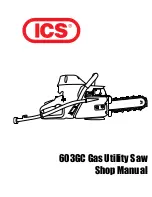
KSS300
01/2022
11
-
Support large panels to reduce the risk of a kickback from a jammed saw blade.
Large panels tend to
sag under their own weight. Panels must be supported on both sides: near the kerf and at the edge.
Fig. 5: Incorrect support vs. correct support
-
Never use blunt or damaged saw blades.
The kerf produced by a saw blade with blunt or incorrectly
aligned teeth is too narrow, causing increased friction, jamming of the saw blade and kickback.
-
Prior to starting sawing, tighten the cutting depth and cutting angle settings.
If the settings change
during the sawing process, there is a risk of a jamming saw blade and kickback.
-
Be particularly careful when sawing into existing walls or other concealed areas.
The saw blade can
jam and cause kickback when cutting into hidden objects.
Function of the lower guard
-
Before each use, ensure that the guard is closed properly. Never use the saw if the guard cannot
move freely and does not close instantly. Never clamp or tie the guard. This would leave the saw
blade unprotected.
The guard can be bent if the saw drops to the ground. Ensure that the guard moves
freely and does not get in contact with the saw blade or other parts at all cutting angles and cutting depths.
-
Check the function of the spring for the lower guard. Have the saw serviced before use if lower
guard and spring do not function properly.
Damaged parts, sticky deposits or accumulations of chips
delay the operation of the lower guard.
-
Open the lower guard manually only to perform special cuts, such as "plunge cuts" or "compound
cuts". Open the lower guard with the retracting lever. Release the lever as soon as the saw blade
penetrates the workpiece.
For all other sawing operations, the lower guard should operate automatically.
-
Ensure that the lower guard covers the saw blade when you put the saw down on the workbench or
on the floor.
An unprotected coasting saw blade moves the saw against the direction of cut and cuts
whatever is in its way. Be aware of the coasting time of the saw blade.












































